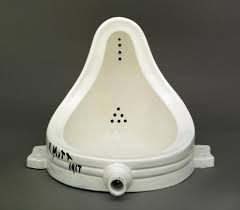When does copying old art become new art? Fair use, the right to limited re-use of copyrighted material without permission or payment, permits not only more efficient work flows but also innovation. Artists are among those who understand the power of unlicensed quotation under fair use.
To celebrate Fair Use/Fair Dealing Week, CMSI is publishing excerpts from the just-released second edition Reclaiming Fair Use: How to Put Balance Back in Copyright (University of Chicago Press). Here’s one:
Readymades.
 The early modern artist Marcel DuChamp was famous for his “readymades”—repurposing of found objects such as a drying rack or a urinal as art. He was also an avid chess player, and he designed an elegant chess set. But the pieces have been lost to time.
The early modern artist Marcel DuChamp was famous for his “readymades”—repurposing of found objects such as a drying rack or a urinal as art. He was also an avid chess player, and he designed an elegant chess set. But the pieces have been lost to time.
In 2014, two U.S. contemporary artists, Scott Kildall and Bryan Cera, recreated them as a 3-D digital model, calling their work Readymake: Duchamp Chess Pieces, and shared the file on the online platform Thingiverse. Between the arch importation of DuChamp’s readymade concept into the digital environment and the homage to a beloved artistic ancestor, the work was a huge hit.
Uh oh.
Except with the DuChamp estate, which asserted the moral rights of the author over a work that had already passed into the public domain. The U.S. does not have moral rights in our law. Although the estate could only affect Kildall’s and Cera’s work in France—the artists only needed to worry about getting sued if they were there—they did not want to be seen as disrespectful to DuChamp’s memory.
Moreover, the original chess set might not have yet entered the public domain. DuChamp died in 1968, and today’s copyright law might extend his claim—because the chess set was an “unpublished work”–until 2038. The facts weren’t totally clear. Kildall and Cera didn’t want to gamble.
Time for fair use to go to work.
Fair Use and Irony Too.

Mustachioed chessmen
Employing the transformative central concept in fair use, they redid their digital design. Now all the chess pieces have little moustaches on them. This is not only an artistic addition that creates a new work, but also an homage to DuChamp’s own famous artwork, L.H.O.O.Q., in which he drew a moustache on a cheap postcard of Da Vinci’s portrait, Mona Lisa.

DuChamp put a moustache and goatee on the Mona Lisa.
Do you want to understand how to employ the U.S. copyright doctrine of fair use in digital art? The College Art Association, with facilitation from CMSI and others, has developed a Code of Best Practices in Fair Use for the Visual Arts. For more stories like this, and for a fuller background on how different creative communities have strengthened their knowledge of the law and improved their work, check out Reclaiming Fair Use, second edition.
